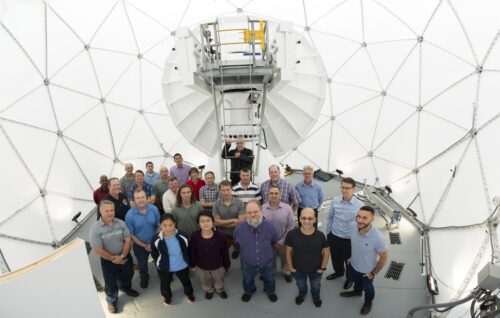The reconfigurable antenna can transmit and receive signals over multiple radio-frequency bands relevant to military and commercial applications.
The Multi-Band Test Terminal (MBTT), a satellite communication(SATCOM) antenna at MIT Lincoln Laboratory can detect and track satellites in medium and low Earth orbit. The Laboratory relied on a variety of smaller antennas for SATCOM testing which include Over-The Air-Ka Band-Test Terminal(OTAKaTT). The MBTT is designed to be easily reconfigured to support multiple radio frequency (RF) bands used for military and commercial satellite SATCOM systems.

“U.S. Space Force’s Protected Anti-Jam Tactical SATCOM (PATS) is developing the capability to deliver protected tactical waveform, or PTW, services over WGS, as well as over commercial transponder satellites and new DoD satellites with dedicated onboard PTW processing,” says Brian Wolf, a technical staff member in Lincoln Laboratory’s Advanced Satcom Systems and Operations Group.
PTW was meant to operate in a wide range of RF bands relevant to satellite communications. The MBTT was designed to support four commonly used bands for SATCOM ranging in frequencies from 7 GHz to 46 GHz: X, Ku, Ka, and Q.
To switch between different supported RF bands, the MBTT is to be reconfigured with a new antenna feed, which emits signals onto and collects signals from the antenna dish, and RF processing components. This takes four to six hours to be completed by a team of skilled technicians before scientists can run any tests on the antenna. The MBTT antenna has supported a wide range of tests and experiments including PTW. It has also been a part of test over several satellites like the EchoStar 9 commercial satellite, DoD-operated WGS satellites, and Inmarsat-5.

“Inmarsat-5 provides a military Ka-band transponded service suitable for PTW, as well as a commercial Ka-band service called Global Xpress,” explains Wolf. “Through the flight tests, we were able to demonstrate resilient end-to-end network connections across multiple SATCOM paths, including PTW on military Ka-band and a commercial SATCOM service. This way, if one satellite communications link is not working well — maybe it’s congested with too many users and bandwidth isn’t sufficient, or someone is trying to interfere with it — you can switch to the backup secondary link.”
The Laboratory looks forward to performing more testing with more user communities in the DoD. As PTW reaches operational maturity, the MBTT, as a reference terminal, could support testing of vendors’ systems. And as PTS satellites with onboard PTW processing reach orbit, the MBTT could contribute to early on-orbit checkout, measurement, and characterization.





